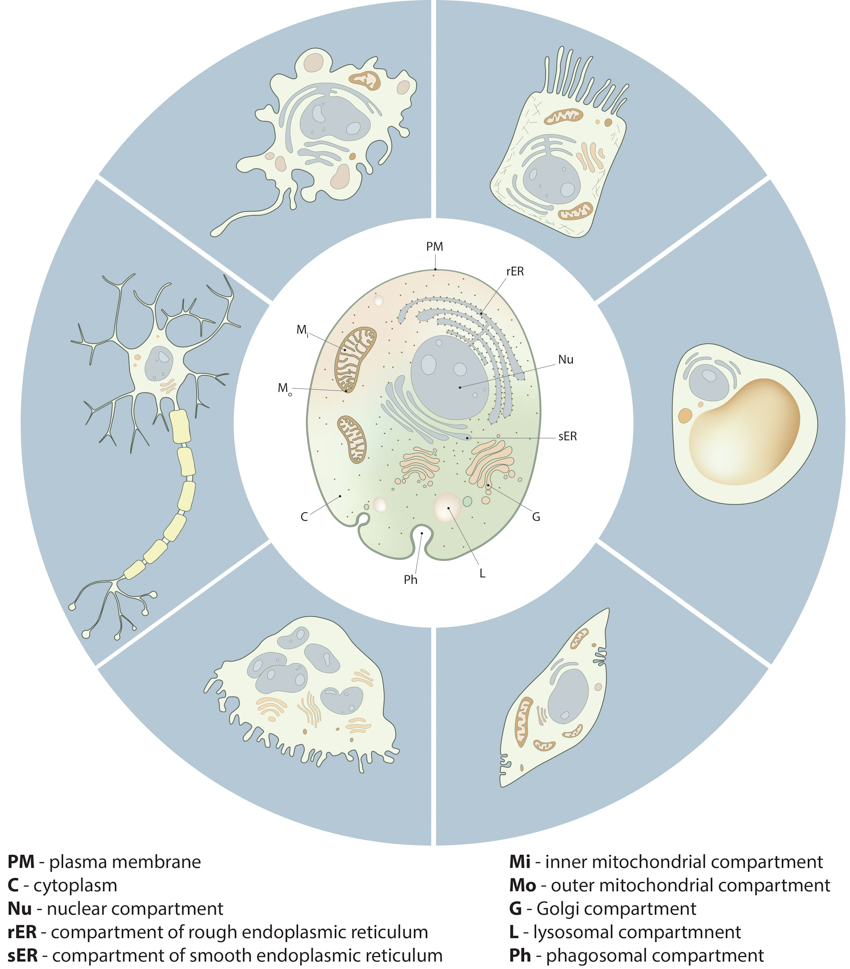The Cell
Cells are the basic units of life; small machines that facilitate and sustain every process within a living organism. Muscle cells contract to maintain a heartbeat and allow us to move, neurons form networks that give rise to memories and enable thought processes. Epithelial cells arrange to form surface barriers between tissues and the many cavities throughout our bodies. Not only do different cell types facilitate unique functions, but their molecular, genetic and structural compositions may also differ. For this reason, different cell types often possess variations in phenotype, such as cell size and shape.
A cell’s function is achieved through the culmination of hundreds of smaller processes, many of which are dependent on each other, and share protein or molecular components. Despite the phenotypic and functional variations that exist between cell types, it remains true that a high level of similarity exists when exploring subcellular processes, the components involved, and importantly, the organization of these components.
With most subcellular processes under precise regulatory control of other subcellular processes, and with components often shared between different molecular pathways and protein cascades, cellular organization is of great importance. This is true for every cell type, with compartmentalization of subcellular processes, and protein localization, recruitment and delivery ensuring they are constantly repeated in an efficient manner and with accurate results.
At a basic level eukaryotic cells can be described as containing three distinct sub-cellular regions; namely the membrane, the cytosol and the nucleus. However cellular compartmentalization is further complicated by the abundance of specific organelles.
Despite being just several nanometers in width, cellular membranes are highly enriched in signaling receptors, transmembrane mechanosensors, pumps and channels, and, depending on their makeup, can recruit and retain a pool of mechanosensors important in the field of mechanobiology. In many cases these mechanosensors interact with the cytoskeleton, which resides in close proximity to the membrane. The cytosol on the other hand houses cellular organelles, including the Golgi, the endoplasmic reticulum (ER), ribosomes and numerous vesicles and vacuoles. Soluble proteins may exist in this region. Meanwhile, the nucleus houses the genetic material and all components related to its expression and regulation. Although the processes of the nucleus are not as well established in terms of their role in mechanobiology, recent findings indicate several important connections, often with the mechanotransduction signaling pathways culminating in alterations to gene expression.
Each of these sub-cellular regions must work coherently for the survival and efficient functioning of the cell. The adequate organization of organelles, proteins and other molecules throughout each region allows individual protein components to function in concert with each other, effectively driving individual subcellular processes that culminate in an overall cellular function.

Despite the morphological and functional variety of cells from different tissue types and different organisms, all cells share important similarities in their compartmental organization. These fundamental compartments, often referred to as organelles, are summarized in the drawing of the generic animal cell (central cell). Examples of specialized cell types, shown around the generic cell, include neuron, macrophage, intestine epithelial cell, adipocyte, muscle cell and osteoclast.
Compartmentalization in cells
Cells are not an amorphous mixture of proteins, lipids and other molecules. Instead, all cells are comprised of well-defined compartments, each specializing in a particular function. In many cases subcellular processes may be described based on whether they occur at the plasma membrane, within the cytosol or within membrane bound organelles such as the nucleus, Golgi apparatus or even vesicular components of the membrane trafficking system like lysosomes and endosomes.
Compartmentalization increases the efficiency of many subcellular processes by concentrating the required components to a confined space within the cell. Where a specific condition is required to facilitate a given subcellular process, this may be locally contained so as not to disrupt the function of other subcellular compartments. For example, lysosomes require a lower pH in order to facilitate degradation of internalized material. Membrane bound proton pumps present on the lysosome maintain this condition. Similarly, a large membrane surface area is required by mitochondria to efficiently generate ATP from electron gradients across its lipid bilayer. This is achieved through the structural composition of this particular organelle.
Importantly, individual organelles may be transported throughout the cell, and this essentially localizes entire subcellular processes to regions where they are required. This has been observed in neurons, which have extremely long axonal processes and require mitochondria to generate ATP at various locations along the axon. It would be inefficient to rely on the passive diffusion of ATP down the length of the axon.
Compartmentalization can also have important physiological implications. For example, polarized epithelial cells, which possess distinct apical and basolateral membranes, can, for instance produce a secretory surface for various glands. Similarly, neuronal cells develop effective networks due to the production of dendrites and axonal processes from opposite ends of the cell body. Moreover, in the case of embryonic stem cells, cell polarization can result in distinct fates of the daughter cells.
With each organelle facilitating its own function, they may be considered as subcellular compartments in their own right. However, without a regulated supply of components to the compartment, the processes and mechanisms that produce their overall function will be impeded. With many proteins and molecular components participating in multiple subcellular processes, and therefore required throughout multiple subcellular compartments, effective transport of the protein and molecular components, either by passive diffusion or directed recruitment, is essential for the overall function of the cell.


